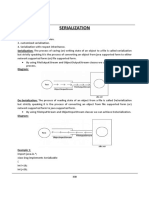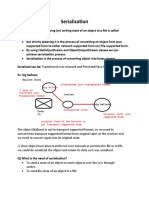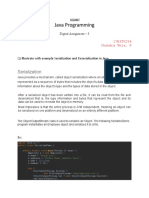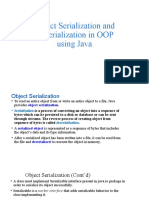0% found this document useful (0 votes)
41 views12 pagesSerialization and Deserialization and Threading
The document discusses serialization and deserialization in Java. Serialization converts an object to a byte stream, while deserialization reconstructs the object from the byte stream. The example code shows how to serialize an object to a file and then deserialize it, demonstrating that transient and static variables are not serialized.
Uploaded by
Hashim AliCopyright
© © All Rights Reserved
We take content rights seriously. If you suspect this is your content, claim it here.
Available Formats
Download as PDF, TXT or read online on Scribd
0% found this document useful (0 votes)
41 views12 pagesSerialization and Deserialization and Threading
The document discusses serialization and deserialization in Java. Serialization converts an object to a byte stream, while deserialization reconstructs the object from the byte stream. The example code shows how to serialize an object to a file and then deserialize it, demonstrating that transient and static variables are not serialized.
Uploaded by
Hashim AliCopyright
© © All Rights Reserved
We take content rights seriously. If you suspect this is your content, claim it here.
Available Formats
Download as PDF, TXT or read online on Scribd
/ 12
























































































